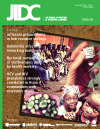HCV and HIV prevalences strongly correlated in Asian communities with reservoirs of HIV in high-risk groups
DOI:
https://doi.org/10.3855/jidc.827Keywords:
hepatitis C virus (HCV), human immunodeficiency virus (HIV), prevalence, iatrogenic diseaseAbstract
Background: In some Asian communities, HIV epidemics initially concentrated in high-risk groups develop into generalized epidemics, while in others HIV epidemics remain confined to high-risk groups. We examined whether blood exposures in a community, as indicated by hepatitis C virus (HCV) prevalence, can account for the variability in HIV prevalence in Asia.
Methodology: We searched the published literature for temporally comparable HCV and HIV prevalence estimates for pregnant women and other "low-risk" population segments in Asian communities with established HIV epidemics in injection drug users or prostitute women. We assessed the correlation between HCV and HIV prevalences in these communities.
Results: HCV and HIV prevalences were strongly correlated (r = .97, p < .001).
Conclusion: This finding suggests that blood-borne transmission drives generalized HIV epidemics in Asia and highlights the need for appropriately designed investigations of transmission modes.Downloads
Published
How to Cite
Issue
Section
License
Authors who publish with this journal agree to the following terms:
- Authors retain copyright and grant the journal right of first publication with the work simultaneously licensed under a Creative Commons Attribution License that allows others to share the work with an acknowledgement of the work's authorship and initial publication in this journal.
- Authors are able to enter into separate, additional contractual arrangements for the non-exclusive distribution of the journal's published version of the work (e.g., post it to an institutional repository or publish it in a book), with an acknowledgement of its initial publication in this journal.
- Authors are permitted and encouraged to post their work online (e.g., in institutional repositories or on their website) prior to and during the submission process, as it can lead to productive exchanges, as well as earlier and greater citation of published work (See The Effect of Open Access).








